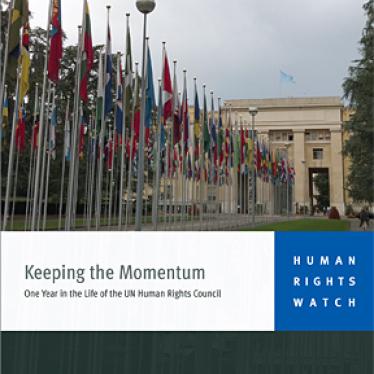Myth: Syria has stopped all military and policing operations.
Reality: At least 49 people have died in operations by Syrian forces since August 17, 2011.
On August 17, President Bashar al-Assad claimed in a telephone conversation with UN Secretary-General Ban Ki-moon that “military and policing operations had stopped.” But that same day, and in the days that followed, Syrian forces attacked peaceful protesters in Homs, Latakia, towns in the governorate of Daraa, and suburbs of Damascus. On August 19 alone, 31 protesters were killed by Syrian security forces, including 3 children, according to local activists. On August 22 in Homs, Syrian forces fired on a crowd of peaceful protesters shortly after a UN humanitarian assessment team left the area, killing 4.
Myth: Syrian forces need to use lethal force to repel attacks by armed groups.
Reality: While a small number of protesters have used force, there is no organized armed opposition, and the overwhelming majority of those killed have been peaceful.
President al-Assad has said he is pursuing a battle against “terrorist groups” and “armed gangs,” and Syrian authorities have claimed that they have “exercised maximum restraint while trying to control the situation.” Neither claim is true. Some protesters have used force against Syrian security forces, often in response to security force shootings or to secure the release of protesters captured by the security forces, but they are a small minority of those involved in the protests. The few protesters who have resorted to force have largely used Molotov cocktails, stones, and hunting rifles, which are no match for the weapons of Syrian forces, including tanks. The few incidents of violence by the protesters should be investigated and those responsible brought to justice. However, the massive and systematic use of lethal force by security forces has been clearly disproportionate to any threat presented by the overwhelmingly unarmed and peaceful demonstrators.
The vast majority of the more than 2,000 civilian deaths documented by local human rights groups have occurred in circumstances in which there was no threat to Syrian forces. There are extensive and well-documented accounts of lethal force being used against peaceful protesters in Daraa, Homs, Douma, Latakia, Rastan, Deir al-Zor, Idlib, and Maaret al-Nu`man. (See, for example, Human Rights Watch’s June 2011 report “‘We’ve Never Seen Such Horror': Crimes against Humanity by Syrian Security Forces”.) Defectors from Syria’s security forces have confirmed that they were given orders to fire on unarmed protesters.
Myth: Armed gangs have killed hundreds of members of the Syrian security forces.
Reality: There are credible accounts that many of the Syrian forces who have died were killed by other members of the security forces.
Some Syrian security forces have been killed by anti-government protesters who took up arms, including in Daraa, Tal Kalakh, and Jisr al-Shughur. But the circumstances and number of these deaths is very uncertain, and there are credible reasons to believe that some of dead security forces were killed by other members of the security forces. Security force members who defected have told Human Rights Watch of cases in which soldiers who defected or refused to take up arms were shot by officers, for example. The Syrian government has not published a list of dead security forces, while antigovernment activists have compiled a list of 394 security members killed.
Myth: Syrian security forces used excessive force early in this crisis, but the situation has improved.
Reality: While hundreds of deaths did occur in the first month of the crisis, attacks on peaceful protesters have continued at an alarming rate.
President al-Assad has claimed that “some mistakes had been made by security forces in the initial stages of the unrest and that efforts were under way to prevent their recurrence.” But the reality is that the pattern of abuses that began in March has continued unabated. According to lists of deaths compiled by local activists and reviewed by Human Rights Watch, security forces killed more than 300 civilians in June and at least 300 more in July. Security forces had already killed more than another 332 civilians by August 20. In addition, the other aspects of the repression – arbitrary and incommunicado detention, rampant torture, and denial of medical care –have continued unabated.
Myth: Syria is investigating the attacks on protesters through a judicial committee established in March.
Reality: Not a single case has been initiated against those responsible for use of excessive force against protesters.
Syria established a judicial committee to “investigate all crimes committed against demonstrators and security personnel” in Daraa on March 31 and later extended the mandate of that committee to cover all of Syria. But despite that mandate, there is not a single reported case of an attack on a protester being investigated or prosecuted. This fits a broader patter of impunity in Syria, where judicial authorities lack independence and security forces are shielded by law from legal action. Legislative Decree No. 14 of January 15, 1969, which established the General Intelligence Division (Idarat al-Mukhabaraat al-`Ama), one of Syria’s largest security apparatuses, provides that, “No legal action may be taken against any employee of General Intelligence for crimes committed while carrying out their designated duties … except by an order issued by the Director.” To Human Rights Watch’s knowledge, the director of General Intelligence has issued no such order. On September 30, 2008, President al-Assad issued Legislative Decree 69, which extended this immunity to members of other security forces, by requiring a decree from the General Command of the Army and Armed Forces in order to prosecute any member of the internal security forces, political security, or customs police.
Myth: Syria is undertaking significant reforms that will resolve the current crisis, if given time.
Reality: The reforms promised by President al-Assad are entirely undermined by the ongoing crackdown by Syrian security forces.
Syria’s authorities have promised and, in certain areas, enacted a number of reforms since anti-government protests erupted in mid-March. However, the ongoing repression on the ground has completely undermined these reforms and raises questions about the authorities’ intention to carry them through. For example, on April 21, President al-Assad lifted the state of emergency, but his security forces continue to detain people arbitrarily and only refer a small number to judicial authorities. On July 28, Syrian authorities adopted a new law on political parties and later issued a decree for a general elections law, but security services continue to detain political activists, forcing most opposition activists to go into hiding. In such an atmosphere, in which security forces remain very much above and outside the law, it is impossible to imagine Syria’s authorities tolerating meaningful political differences.






